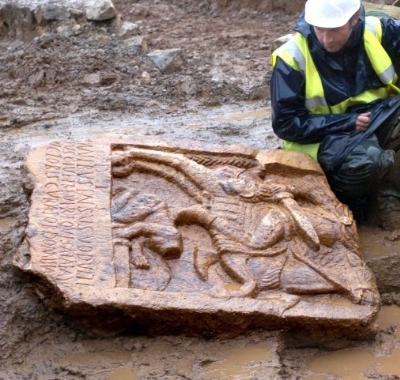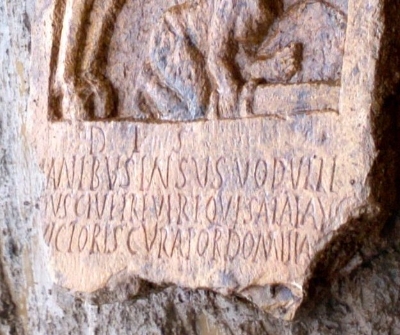 Towards
the end of last year this fantastic find was discovered in excavations prior to housing
development on the outskirts Lancaster. The work was carried out by a team from Manchester
University headed by Dave Powers and Peter Noble. As you can see, the tablet depicts a
cavalryman subduing his enemy; a not too unfamiliar theme for this type of sculptured
stone. However what makes this so unusual is that he is shown with a sword in his hand
instead of the usual lance. If you look closely you can also see that the soldier has
decapitated his opponent with it. Look again and you will see he is clutching the severed
head by the hair in his sword hand. Peter Iles from Lancashire County Council’s
Archaeological Services says he has not seen another example like it, certainly not in
this country. Peter also says that the archaeologists did not find a burial associated
with it, but ditches found nearby are suggestive of a mortuary enclosure, which points to
this being a memorial stone or stele rather than a gravestone. Towards
the end of last year this fantastic find was discovered in excavations prior to housing
development on the outskirts Lancaster. The work was carried out by a team from Manchester
University headed by Dave Powers and Peter Noble. As you can see, the tablet depicts a
cavalryman subduing his enemy; a not too unfamiliar theme for this type of sculptured
stone. However what makes this so unusual is that he is shown with a sword in his hand
instead of the usual lance. If you look closely you can also see that the soldier has
decapitated his opponent with it. Look again and you will see he is clutching the severed
head by the hair in his sword hand. Peter Iles from Lancashire County Council’s
Archaeological Services says he has not seen another example like it, certainly not in
this country. Peter also says that the archaeologists did not find a burial associated
with it, but ditches found nearby are suggestive of a mortuary enclosure, which points to
this being a memorial stone or stele rather than a gravestone.
As you can see the inscription is quite distinct. A number of experts are currently
working on its translation including David Shotter, Andrew White and Ben Edwards.
Preliminary results indicates that this was a Roman trooper with the Ala Augusta, a
cavalry unit which is know to have been operating in the Lancaster area. His name was
probably (L)insus Vodulli and the inscription states that he was a citizen of the Treveri.
These were a Belgic tribe originating from the lower valley of the Mosella in Germany and
whose capital was at Trier. The inscription is undated but its style suggests early 2nd
century. This ties in with evidence from other inscriptions indicating this unit was
active in the area at that time. The stone was discovered in several pieces, lying
about eight metres or so from the Roman road from Lancaster to Walton-le-Dale, a section
of which had been uncovered during the excavations. Restoration work has begun and will
include re-attaching the pieces, which is always a difficult business with large stones
such as this. The excavations have ceased now but the University team is keeping a
watching brief on the site as the development continues. Programme
Details have not yet been finalised but we have already secured a number of very
interesting speakers for the coming year. These include Zosia Archibald from Liverpool
University who will presenting a talk on Pheidias, the famous Athenian sculptor, and Also
Peter Iles from Lancashire County Council Archaeological Services will be coming later in
the year to talk about Motte and Bailey Castles in the Lune Valley. Next month we have
David Ratledge who runs Lancashire County Council’s comprehensive Historic Highways
website. His talk is on the Roman Roads in the north Lancashire area.
A visit to Hardian’s Wall and Vindolanda has been suggested for this year’s
summer trip but other suggestions are welcome.
Excavation Potential
Last year’s work in Ellesmere Park, Eccles was very rewarding with a neat section
of Roman road being uncovered (see Newsletter 85). John Rabbitt
who organised the project is now looking at another site further west at Chorlton Fold.
New development is being considered for this area so it could be crucial to check this out
before the evidence is lost forever. John has made strong representations to the
authorities, which will hopefully allow us to start work early this summer.
Next Meeting
Wednesday 1st February at the Baden Powell Centre (Scout HQ) in Greenough Street,
starting at 7.30 pm as usual. As it is the AGM the first half-hour will
be society business (nominees for officers accepted), then Adrian Morris
has prepared a slideshow of last year’s successful trip to Angers.
Hope to see you there. B.A. |



